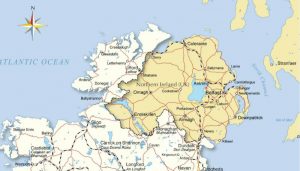
Brexit’s Irish trade problem looks ever more complex, assuming that the UK continues with its intent to leave the customs union and single market. When two customs areas exist there is a need for a border. The fear is that this must be a hard border for goods (services and people are different), if only to ensure standards and provenance apply as well as deliver all applicable tax revenue streams.
Many already know the story of the ingredients of a can or pint of Guinness. In its ‘assembly’ this needs to cross the N Ireland/Republic of Ireland border (the border) multiple times. At present this happens without problems. No tariff, source or standards checks apply – because both the UK and Republic of Ireland are members of the EU.
Post-Brexit this will no longer be the case. In which case a hard border – with all the paraphernalia of borders – will need re-establishment.
This far the UK Government has mouthed specious pleasantries about its desire to avoid such a hard border, yet without offering any credible suggestions. Weasel words involving “innovative solutions” including the creation of a “virtual” or technological border between the two countries never fail to fall out of ministerial mouths.
Though the UK Government has not proposed it, blockchain-based supply chains with RFID might offer some part of an answer.
Some of Brexit’s Irish trade problems
If enterprises wish to trade goods (again, not services or people) across the border, then several aspects need covering. Besides the tax and tariff implications, assuming there is no reciprocal equivalence, there are the complementary aspects of provenance and quality standards to respect. In the latter case, for example, the EU does not want the USA’s now notorious chlorinated chicken to ‘leak’ through from (say) England to N. Ireland and into the Republic (or onto the Continent). Equally both Republic and Northern Ireland businesses want to continue to buy and sell across the border without quality, sourcing and tax calculations plus checks every time a ‘good’ crosses the border line.
Yet this is what must happen unless some alternative ‘solution’ emerges. It is why blockchain/RFID supply chains might work. The caveat: someone would have to build them.
Blockchain/RFID supply chains
Step back from all the Brexit bluster. Address the problems – essentially taxation/tariffs, provenance and quality.
Imagine that (say) a major supermarket in the North of Ireland sourced many of the ingredients it sells from the Republic. Today, milk, butter, cheese, Peking Duck, beef and whatever move seamlessly into that supermarket chain’s distribution centre in the North.
Take a further step forward, past Brexit. What if the supermarket established its own blockchain for its suppliers. The producers of the milk, butter, cheese, Peking Duck, beef and whatever would tag what they were selling to the supermarket at source. This might be by pairs of (for example) Peking Duck breasts or boxes containing 100 such breasts. The RFID chip would relate to an input which the producer would enter onto the supermarket’s blockchain. This would include, among other details, a full description, provenance, value, date of production, description, tariffs/taxes applicable, etc.
A logistics company would pick up the goods. That would see it make its entry onto the blockchain. It would transport these goods from the Republic over the border to the supermarket chain distribution center in the North. Receipt in the supermarket distribution centre would trigger a further update to the blockchain, as might further deliveries within the supermarket network of stores. (This deliberately over-simplifies, for the purposes of illustration.)
Why might this be interesting in the Brexit’s Irish trade context
Once the initial entry occurs on the blockchain it becomes visible to all authorised participants. These include the producer, the logistics company, the supermarket chain and the tax authorities on both sides of the border. All goods would have a blockchain entry capable of electronic inspection.
For the supermarket chain: it would have a clear picture of the whole supply chain, from origination through to arrival at good inwards. Besides supply and stock control this could automatically feed its financial and payment systems. Moreover, it would provide documentary evidence of origin, provenance and meeting applicable standards.
The original producer would, probably, be less happy. Rather than, as now, bundling up the Peking Duck for sending of with just an invoice attached, producing enterprises would have to add the RFID tagging plus the related entry onto the supermarket’s blockchain. This would be an additional burden. Yet, if it might also release payment by the supermarket sooner, then it might welcome. In addition, the delivery process would be transparent. The producer could ‘see’ progress from the farm yard through to delivery acceptance (which is often not possible now). If there was a logistics snafu which meant that the good ‘went off date’, it would be clear whose responsibility this was.
For the customs and tax authorities the position would be near to nirvanha. Not only would all goods posses a value, against which to calculate taxes and tariffs, but the whole process end to end is visible. Indeed, customs personnel could monitor the blockchain, assuming the supermarket granted access. It could arrange to perform random checking. This might happen at the supermarket distribution centre, a lorry park or at the ports (if the goods were moving via N Ireland to the rest of the UK or vice versa if from the North to the continent via the Republic).
Will this satisfy everybody?
The simple answer has to be no. There are always, and especially in Ireland, other issues. This approach would work best for authorised economic operators (AEOs in the jargon). It clearly would not be appropriate for small businesses, unless they chose to sign up because of other less obvious benefits.
Nevertheless, if the greater part of the UK exports to Ireland and Irish exports to the UK (worth £26.7 billion and £20.8 billion respectively) were able to use a blochchain/RFID approach, then the need for a visible hard border for goods would diminish if not largely disappear. Replacing hard border posts for goods would be customs checks at the point of delivery or arrival (or departure) in the North and in the Republic or at ports as goods left the island of Ireland. RFID tagging would also accelerate customs inspections as well as connect data to the goods themselves. Taxation and tariff issues would become electronic issues rather than physical ones – this is where the immutability of blockchain has its merits.
Implications
The idea for this brief exploration originated with an interesting discussion with a company called Reply. It, for example, offers a number of Reply Blockchain Accelerators covering a number of industries. These form building blocks for enterprises, and potentially governments, to explore and adapt blockchain models to the specific realities required.
In theory, Reply is in an enviable position. It could assist the notional supermarket chain described above. It could help the producers. Even governments might take notice. In an ideal world, the UK and Republic of Ireland Governments would conceive of and build an Intra-Ireland Trade Blockchain (IITB) so that all enterprises doing significant business across the border have their goods/transactions registered on this IITB.
But an IITB won’t happen, in ET’s judgement. UK Government-sponsored IT projects have a dismal record of delivering, and almost never on time or within budget. This matters when an IITB needs implementation within three years (before the end of any transation period). Such ‘reckless’ speed exceeds the capability of the Civil Service. There is no reason to think that the Republic of Ireland would be much better.
The one possible way forward, (which is less economically efficient than an IITB) would occur if individual industries or enterprises (like the supermarket chain envisaged above) picked up the blockchain baton and implemented blockchain-backed supply chain solutions. Their motivation would be ‘simple economic self-interest’ (though too many such initiatives might become counter-productive).
The intriguing aspect about such enterprise-driven initiatives is that the tax/tariff authorities could exploit the visibility into the immutable blockchain data to ensure that enterprises paid all appropriate taxes and tariffs. Better still, they would have to do almost nothing, which is probably the best any enterprise could wish for from inept government involvement (even if the latter is trying to do its best).
What does this mean?
Neither an IITB nor multiple enterprise blockchain initiatives would solve Brexit’s Irish trade problem. But blockchain(s) might help reduce it to being manageable.
18 months after the referendum, and almost a year after serving the Article 50, the UK has proposed nothing. Simultaneously, the EU/Irish say, with justice, that is it the UK which departeth the EU. Thus it is the UK’s problem. Except there is one defence for doing nothing. If the UK does not exit the customs union and single market, such an IITB would be superfluous. It is much cheaper, and simpler, to do nothing in the hope that the problem self-evaporates.


























